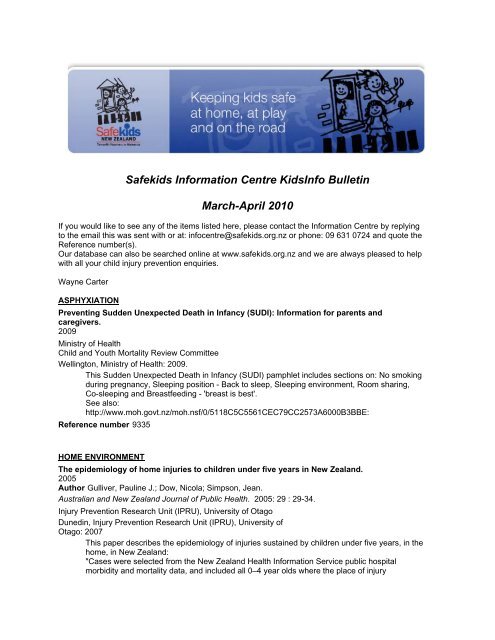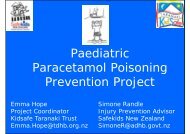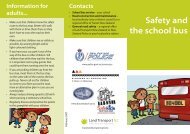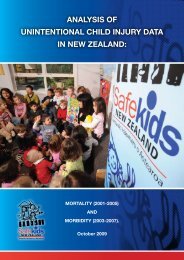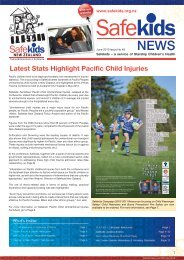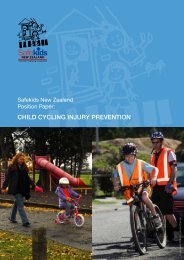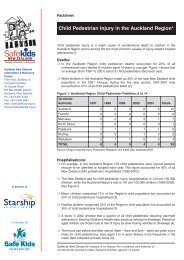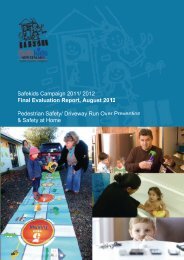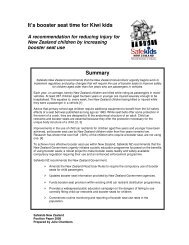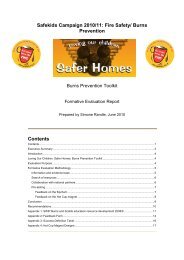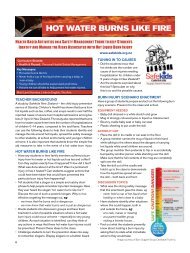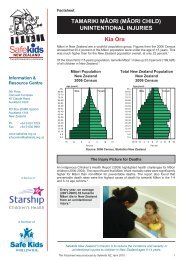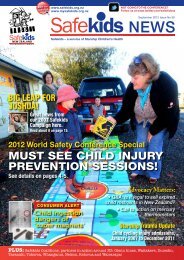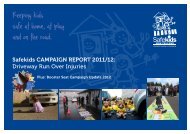Safekids Information Centre KidsInfo Bulletin March-April 2010
Safekids Information Centre KidsInfo Bulletin March-April 2010
Safekids Information Centre KidsInfo Bulletin March-April 2010
You also want an ePaper? Increase the reach of your titles
YUMPU automatically turns print PDFs into web optimized ePapers that Google loves.
<strong>Safekids</strong> <strong>Information</strong> <strong>Centre</strong> <strong>KidsInfo</strong> <strong>Bulletin</strong><br />
<strong>March</strong>-<strong>April</strong> <strong>2010</strong><br />
If you would like to see any of the items listed here, please contact the <strong>Information</strong> <strong>Centre</strong> by replying<br />
to the email this was sent with or at: infocentre@safekids.org.nz or phone: 09 631 0724 and quote the<br />
Reference number(s).<br />
Our database can also be searched online at www.safekids.org.nz and we are always pleased to help<br />
with all your child injury prevention enquiries.<br />
Wayne Carter<br />
ASPHYXIATION<br />
Preventing Sudden Unexpected Death in Infancy (SUDI): <strong>Information</strong> for parents and<br />
caregivers.<br />
2009<br />
Ministry of Health<br />
Child and Youth Mortality Review Committee<br />
Wellington, Ministry of Health: 2009.<br />
This Sudden Unexpected Death in Infancy (SUDI) pamphlet includes sections on: No smoking<br />
during pregnancy, Sleeping position - Back to sleep, Sleeping environment, Room sharing,<br />
Co-sleeping and Breastfeeding - 'breast is best'.<br />
See also:<br />
http://www.moh.govt.nz/moh.nsf/0/5118C5C5561CEC79CC2573A6000B3BBE:<br />
Reference number 9335<br />
HOME ENVIRONMENT<br />
The epidemiology of home injuries to children under five years in New Zealand.<br />
2005<br />
Author Gulliver, Pauline J.; Dow, Nicola; Simpson, Jean.<br />
Australian and New Zealand Journal of Public Health. 2005: 29 : 29-34.<br />
Injury Prevention Research Unit (IPRU), University of Otago<br />
Dunedin, Injury Prevention Research Unit (IPRU), University of<br />
Otago: 2007<br />
This paper describes the epidemiology of injuries sustained by children under five years, in the<br />
home, in New Zealand:<br />
"Cases were selected from the New Zealand Health <strong>Information</strong> Service public hospital<br />
morbidity and mortality data, and included all 0–4 year olds where the place of injury
occurrence was classified as 'home'. The circumstances of injury were coded according to the<br />
Supplementary Classifications of External Causes of Injury and Poisoning (E-codes) of the<br />
International Classifications of Diseases. Age-specific rates of death or hospitalisation due to<br />
injury were calculated using the population of 0–4 year olds in New Zealand for each year as<br />
the denominator.<br />
Conclusion and Implications: Although there has been an apparent decrease in the number of<br />
children hospitalised for injuries sustained in the home environment, it is not possible to<br />
determine if this is a 'real' change or a result of other factors affecting the data. While children<br />
continue to be killed and injured as a result of preventable incidents in the home environment,<br />
injury prevention strategies should be continued and strengthened."<br />
Reference number 9347<br />
HOME ENVIRONMENT - NZ<br />
Clause B1 Structure [New Zealand Building Code Compliance Document].<br />
2001<br />
www.dbh.govt.nz<br />
Department of Building and Housing (DBH)<br />
Wellington, Department of Building and Housing: 2001<br />
This New Zealand Building Code Compliance Document is of interest as it relates to the<br />
prevention of child falls and timber barrier fencing, see especially section 1.0.<br />
Up-to-date version available at:<br />
http://www.dbh.govt.nz/building-code-compliance-documents#free-download<br />
Reference number 9341<br />
Clause D1 Access routes [New Zealand Building Code Compliance Document].<br />
2001<br />
www.dbh.govt.nz<br />
Department of Building and Housing (DBH)<br />
Wellington, Department of Building and Housing: 2001<br />
This New Zealand Building Code Compliance Document is of interest as it relates to the<br />
prevention of child falls on stairs and entrapment between them, see especially section 4.1.8.<br />
Up-to-date version available at:<br />
http://www.dbh.govt.nz/building-code-compliance-documents#free-download<br />
Reference number 9342<br />
Clause F2 Hazardous building materials [New Zealand Building Code Compliance Document].<br />
2001<br />
www.dbh.govt.nz<br />
Department of Building and Housing (DBH)<br />
Wellington, Department of Building and Housing: 2001<br />
This New Zealand Building Code Compliance Document is of interest as it relates to the<br />
prevention of cutting and piercing injuries to children and the use of Safety Glass, see<br />
especially section 1.0 Glazing.<br />
Up-to-date version available at:<br />
http://www.dbh.govt.nz/building-code-compliance-documents#free-download<br />
Reference number 9343
Clause F5 Construction and demolition hazards [New Zealand Building Code Compliance<br />
Document].<br />
2001<br />
www.dbh.govt.nz<br />
Department of Building and Housing (DBH)<br />
Wellington, Department of Building and Housing: 2001<br />
This New Zealand Building Code Compliance Document is of interest as it relates to the<br />
prevention of child injury at construction or demolition sites, see especially section 1.0 Work-<br />
Site Barriers.<br />
Up-to-date version available at:<br />
http://www.dbh.govt.nz/building-code-compliance-documents#free-download<br />
Reference number 9344<br />
Clause G12 Water supplies - Third Edition [New Zealand Building Code Compliance<br />
Document].<br />
2001<br />
www.dbh.govt.nz<br />
Department of Building and Housing (DBH)<br />
Wellington, Department of Building and Housing: 2001<br />
This New Zealand Building Code Compliance Document is of interest as it relates to the<br />
prevention of child hot tap water burns and scalds in the home, see especially section 6.14<br />
Safe water temperatures. This includes details about hot tap water tempering valves and how<br />
they work and must be installed.<br />
Up-to-date version available at:<br />
http://www.dbh.govt.nz/building-code-compliance-documents#free-download<br />
Reference number 9345<br />
Handbook to the Building Code and Compliance Documents [New Zealand Building Code<br />
Compliance Document].<br />
2007<br />
www.dbh.govt.nz<br />
Department of Building and Housing (DBH)<br />
Wellington, Department of Building and Housing: 2007<br />
This handbook to the New Zealand Building Code and Compliance Documents is of interest<br />
as it includes an index to the Compliance Documents which includes 'children' and directs you<br />
to the relevant Documents. It includes an overview of how the Building Act, Building<br />
Regulations and Building Code interrelate and interact.<br />
Up-to-date version available at:<br />
http://www.dbh.govt.nz/building-code-compliance-documents#free-download<br />
Reference number 9346<br />
INJURY PREVENTION<br />
Injuries in the European Union - Statistics Summary 2005 – 2007.<br />
2009
Author Bauer, Robert; Steiner, Monica<br />
Eurosafe (European Association for Injury Prevention and Safety Promotion).<br />
European Child Safety Alliance.<br />
Vienna, Eurosafe: 2009. 40 p.<br />
The 2009 report “Injuries in the EU” has been launched this week by EuroSafe. The report<br />
presents data collected over the years 2005-2007. It also highlights injury data related to<br />
major risk groups and injury causes as identified in the EU-Council recommendation on injury<br />
prevention and safety promotion: children, adolescents, senior citizens, pedestrians/ bicyclists,<br />
sporting activities, consumer products, interpersonal violence and self-harm. Includes the<br />
statements that:<br />
"More than 5 000 children die from injury each year in the EU leaving a legacy of sorrow and<br />
grief to their parents, relatives and friends.<br />
Injury is the leading cause of childhood death in the EU, accounting for 32% of all deaths of<br />
children between 1 and 14 years of age (Figure 2).<br />
Five well known types of accidents – road traffic, drowning, falls (from height), fires and<br />
poisoning - account for almost 60% of all fatal child injuries up to 14 years (Figure 2).<br />
These five main causes are known to be preventable (up to 90%) by appropriate measures,<br />
e.g. child restraint systems, pool fencing, smoke alarms, window guards and child restraint<br />
packaging."<br />
Available at:<br />
\http://osha.europa.eu/en/news/Injuries-in-the-<br />
EuropeanUnion?sourceid=rss&utm_source=home&utm_medium=rss&utm_campaign=rssfeeds<br />
Reference number 9338<br />
PASSENGERS<br />
High back booster seats: in the field and in the laboratory.<br />
2006<br />
Author Bilston, Lynne E.; Brown, Julie<br />
Annual Proceedings/ Association for the Advancement of Automotive Medicine 2006; 50: 345-59.<br />
Prince of Wales Medical Research Institute, UNSW, Randwick NSW, Australia<br />
High back booster (HBB) seat use was studied in the field and in the laboratory. This paper<br />
presents details of a case series of 19 children using HBBs in real world crashes. More than<br />
half were using HBBs when a forward facing restraint would have been more suitable (i.e.<br />
inappropriately), and incorrect use was identified in 3 cases. All serious injury occurred in<br />
children inappropriately or incorrectly using HBBs. Laboratory simulations modelled on real<br />
world cases demonstrate a greater injury potential in misused HBBs than in correctly used<br />
HBBs due to excessive upper body excursion.<br />
Reference number 9349<br />
PASSENGERS - CHILD RESTRAINTS - NZ<br />
<strong>Safekids</strong> position paper: It’s booster seat time for Kiwi kids: A recommendation for reducing<br />
injury for New Zealand children by increasing booster seat use. (Updated January 2009.)<br />
2009<br />
Author Chambers, Julie<br />
<strong>Safekids</strong> New Zealand - Tamariki Haumaru o Aotearoa<br />
Auckland, <strong>Safekids</strong> New Zealand: 2009<br />
This position paper from <strong>Safekids</strong> NZ advocates for the need for New Zealand Government<br />
regulation to require booster seat use for the many children between the ages of 5 to 15 years
who would benefit from the protection booster seats afford. It reviews relevant international<br />
research to date, describes the public policy issues involved and reviews the way New<br />
Zealand is lagging behind other OECD countries in this area.<br />
This version was updated in January 2009.<br />
Available at:<br />
http://www.safekids.org.nz/index.php/pi_pageid/27<br />
Reference number 9352<br />
Child restraints<br />
Factsheet 7<br />
May <strong>2010</strong><br />
<strong>2010</strong><br />
http://www.nzta.govt.nz/resources/factsheets/07/<br />
New Zealand Transport Agency (NZTA)<br />
New Zealand Government<br />
Wellington, New Zealand Transport Agency (NZTA): <strong>2010</strong>.<br />
This child restraint factsheet (updated May <strong>2010</strong>) gives a general overview of what information<br />
parents and caregivers need to know when children travel in a vehicle. This includes what the<br />
legal requirements are for restraining children in a vehicle, as well as what information you<br />
need to know when renting or purchasing (new and used) child restraints, and the fitting of<br />
child restraints into a vehicle. It includes advice about the value of continuing the use of<br />
booster seats for smaller-framed children until they are over the height of 148 cm.<br />
Includes sections on: Your responsibilities as the driver (under the law), Exceptions to the law,<br />
Child safety advice, Standards markings on child restraints, In-built child restraints, Secondhand<br />
child restraints, What to look for when you buy a vehicle, Where can you find out more?<br />
Available at:<br />
http://www.nzta.govt.nz/resources/factsheets/07/<br />
Reference number 9355<br />
PASSENGERS - NZ<br />
Australian/New Zealand Standard AS/NZS 1754:<strong>2010</strong> - Child restraint systems for use in motor<br />
vehicles<br />
<strong>2010</strong><br />
Standards New Zealand - Paerewa Aotearoa<br />
Standards Australia<br />
Wellington, Standards New Zealand: <strong>2010</strong><br />
This Standard specifies the requirements for restraining devices for child occupants of<br />
passenger cars to reduce the risk of bodily injury in a vehicle impact. In particular when they<br />
are: properly selected, correctly installed and correctly adjusted, to reduce risk of bodily injury<br />
in a vehicle impact. The devices may also have application to other types of vehicles.<br />
The objective of the Standard is to provide minimum design, construction and performance<br />
requirements for child restraint systems in order to promote the provision of a high level of<br />
protection for children travelling in motor vehicles.<br />
Reference number 9353<br />
Factsheet: Child motor vehicle passenger injuries.<br />
<strong>2010</strong><br />
Author 'Alatini, Moses
http://www.safekids.org.nz<br />
<strong>Safekids</strong> New Zealand, Tamariki Haumaru o Aotearoa<br />
Auckland, <strong>Safekids</strong> New Zealand: <strong>2010</strong><br />
This is a factsheet revised (from 2009) by <strong>Safekids</strong> NZ for use as part of the <strong>Safekids</strong><br />
Campaign <strong>2010</strong>/11. Child (0-14 years) motor vehicle passenger safety is one of the <strong>2010</strong>/11<br />
Campaign themes.<br />
<strong>Information</strong> and statistics are provided under the following headings: Overview, Incorrectly<br />
fitted child car restraints, Death, Hospitalisation, Cost, Legislation, Standards markings, Lap<br />
belt injuries, Seat positioning.<br />
Available at:<br />
http://www.safekids.org.nz/index.php/page/Factsheets<br />
Reference number 9358<br />
Factsheet: Child motor vehicle passenger injuries: Effectiveness of belt positioning booster<br />
seats.<br />
<strong>2010</strong><br />
Author 'Alatini, Moses<br />
http://www.safekids.org.nz<br />
<strong>Safekids</strong> New Zealand, Tamariki Haumaru o Aotearoa<br />
Auckland, <strong>Safekids</strong> New Zealand: <strong>2010</strong><br />
This is a factsheet revised (from 2009) by <strong>Safekids</strong> NZ for use as part of the <strong>Safekids</strong><br />
Campaign <strong>2010</strong>/11. Child (0-14 years) motor vehicle passenger safety is one of the <strong>2010</strong>/11<br />
Campaign themes.<br />
<strong>Information</strong> and statistics are provided under the following headings: Overview, Best practice,<br />
Effectiveness of belt positioning booster seats, Advantages of using a booster seat, How long<br />
do children need to use a booster seat?<br />
Available at: http://www.safekids.org.nz/index.php/page/Factsheets<br />
Reference number 9359<br />
Australian/New Zealand Standard AS/NZS 3629:<strong>2010</strong> Methods for testing child restraints:<br />
Method 9: Test for length of seating surface on a booster seat.<br />
<strong>2010</strong><br />
Standards New Zealand - Paerewa Aotearoa<br />
Standards Australia<br />
Wellington, Standards New Zealand: <strong>2010</strong><br />
This Standard was prepared by the Joint Standards Australia/ Standards New Zealand<br />
Committee CS-085, Child Restraints for Use in Motor Vehicles.<br />
This method for determining the angle of the lower leg when the dummy is seated on a<br />
booster seat was developed to ensure that the length of the seating surface is not so long as<br />
to prevent child's lower leg from assuming a downward direction.<br />
Reference number 9363<br />
Australian/New Zealand Standard AS/NZS 3629.1:<strong>2010</strong> Methods of testing child restraints:<br />
Method 1: Dynamic testing.<br />
<strong>2010</strong><br />
Standards New Zealand - Paerewa Aotearoa<br />
Standards Australia
Wellington, Standards New Zealand: <strong>2010</strong><br />
This Standard was prepared by the Joint Standards Australia/<br />
Standards New Zealand Committee CS-085, Child Restraints<br />
for Use in Motor Vehicles, to supercede AS/NZS 3629.1:2004.<br />
Provides manufacturers and testing authorities with a method for testing a child restraint under<br />
various dynamic conditions, in order to assess its performance under the requirements of<br />
AS/NZS 1754.<br />
Reference number 9364<br />
Australian/New Zealand Standard AS/NZS 3629.7:<strong>2010</strong> Methods of testing child restraints:<br />
Method 7: Test for suitability of seatbelt length.<br />
<strong>2010</strong><br />
Standards New Zealand - Paerewa Aotearoa<br />
Standards Australia<br />
Wellington, Standards New Zealand: <strong>2010</strong><br />
This Standard was prepared by the Joint Standards Australia/<br />
Standards New Zealand Committee CS-085, Child Restraints<br />
for Use in Motor Vehicles.<br />
Sets out the method to determine the length of seat belt required to install a child restraint and<br />
compares this length with the minimum length required by AS/NZS 2596:2003, ADR 4/04 and<br />
UNECE Regulation 16/04.<br />
Reference number 9365<br />
Australian/New Zealand Standard AS/NZS 3629.8:<strong>2010</strong> Methods of testing child restraints –<br />
Method 8: Test for suitability of booster seat profile.<br />
<strong>2010</strong><br />
Standards New Zealand - Paerewa Aotearoa<br />
Standards Australia<br />
Wellington, Standards New Zealand: <strong>2010</strong><br />
This Standard was prepared by the Joint Standards Australia/<br />
Standards New Zealand Committee CS-085, Child Restraints<br />
for Use in Motor Vehicles.<br />
This test is to ensure that Type F child restraints will fit into most cars and that the seat belt<br />
buckle is accessible for engagement of the tongue.<br />
Reference number 9366<br />
PREVENTION THEORY<br />
While we were sleeping: Success stories in injury and violence prevention.<br />
2009<br />
Author Hemenway, David<br />
Berkeley, University of California Press: 2009, xv, 227 p. ; 23 cm.<br />
Summary: "Public health has made our lives safer - but it often works behind the scenes,<br />
without our knowledge, that is, "while we are sleeping." This book illuminates how public<br />
health works with more than sixty success stories drawn from the area of injury and violence<br />
prevention. It also profiles dozens of individuals who have made important contributions to<br />
safety and health in a range of social arenas. Highlighting examples from the United States as<br />
well as from other countries, While We Were Sleeping will inform a wide audience of readers
about what public health actually does and at the same time inspire a new generation to make<br />
the world a safer place."--BOOK JACKET.<br />
Reference number 9362<br />
ROAD SAFETY - NZ<br />
Starting out safely: Road safety tips for parents and caregivers<br />
of children under five [brochure].<br />
Timata ana ki te haere haumaru atu [Maori].<br />
Kamata'aki'ae mou'ui hao mo malu [Tongan]<br />
'Amataga o le saogalemu [Samoan].<br />
[Korean].<br />
[Mandarin Chinese].<br />
<strong>2010</strong><br />
New Zealand Transport Agency (NZTA)<br />
Wellington, New Zealand Transport Agency: <strong>2010</strong>.<br />
This small booklet publication from the New Zealand Transport Agency (NZTA) is divided up<br />
into general road safety tips and advice in relation to: 'At home and play', 'On foot', 'Kerb drill',<br />
'In the car' and 'Child restraints'. It is available in English, Maori, Tongan, Samoan, Korean<br />
and Mandarin Chinese.<br />
Available at:<br />
http://www.nzta.govt.nz/<br />
Reference number 9348<br />
STATISTICS AND DATA INJURY - NZ<br />
Factsheet: Pacific child unintentional injuries.<br />
<strong>2010</strong><br />
Author 'Alatini, Moses<br />
http://www.safekids.org.nz<br />
<strong>Safekids</strong> New Zealand, Tamariki Haumaru o Aotearoa<br />
Auckland, <strong>Safekids</strong> New Zealand: <strong>2010</strong><br />
This major revision and expansion and of this Pacific child injury factsheet includes detailed<br />
information about the 'youthful' Pacific Peoples population in New Zealand and also includes<br />
information about the causes of injury death and hospitalisation. Describing these causes of<br />
death and injury points to possible preventative interventions.<br />
Available at:<br />
http://www.safekids.org.nz/index.php/page/Factsheets<br />
Reference number 9356<br />
Factsheet: Tamariki Maori (Maori child) unintentional injuries.<br />
<strong>2010</strong><br />
Author 'Alatini, Moses<br />
http://www.safekids.org.nz<br />
<strong>Safekids</strong> New Zealand, Tamariki Haumaru o Aotearoa<br />
Auckland, <strong>Safekids</strong> New Zealand: <strong>2010</strong><br />
This major revision and expansion of this tamariki Maori/ Maori child injury factsheet includes<br />
detailed information about the 'youthful' nature of the Maori population in New Zealand and<br />
also includes information about the leading causes of injury death and hospitalisation. A small
child restraints use improvement case-study points the way to this and other possible<br />
preventative interventions.<br />
Available at:<br />
http://www.safekids.org.nz/index.php/page/Factsheets<br />
Reference number 9357<br />
THERMAL INJURIES - NZ<br />
Get Firewise: Year 1 and 2 [Resource and teaching kit].<br />
Get Firewise teachers' guide. [A4 booklet]<br />
Tamati and Sam Get Firewise [A4 story book]<br />
Get Firewise family book<br />
Get Firewise family DVD<br />
Get Firewise Teachers’ Guide<br />
Get Firewise certificate<br />
Our Firewise Family<br />
Get Firewise Poem Poster<br />
Get Firewise Song Poster<br />
Get Firewise Frieze<br />
Get Firewise Puppet Master Set<br />
Smoke Alarm<br />
Safe Meeting Place Sticker<br />
Tamati Magnetic Picture Set<br />
Get Firewise School DVDs<br />
Display Photographs [A3]<br />
<strong>2010</strong><br />
New Zealand Fire Service - Whakaratonga Iwi<br />
Wellington, New Zealand Fire Service - Whakaratonga Iwi: <strong>2010</strong>.<br />
A teaching kit intended for use by schools for Year 1 and Year 2 students. It includes the<br />
'Tamati and Sam Get Firewise' story book which is aimed at the children and it is intended that<br />
the Fire Service would supply multiple copies to schools (for kids) to accompany a smaller<br />
number of the kits which go to schools. The plan is for schools to do preparation with the kits<br />
before Fire Fighters visit: "There is a strong literacy focus, and the programme is aligned to<br />
the New Zealand Curriculum 2007 and supported by Ministry of Education advisors."<br />
See also:<br />
http://firewise.fire.org.nz/visit.html<br />
Reference number 9337<br />
Tamati and Sam Get Firewise [A4 story book with the 'Get Firewise Family DVD' in the back]<br />
<strong>2010</strong><br />
New Zealand Fire Service - Whakaratonga Iwi<br />
Wellington, New Zealand Fire Service - Whakaratonga Iwi: <strong>2010</strong>.<br />
'Tamati and Sam Get Firewise' is story book which is aimed at early primary school aged<br />
children. It is from a teaching kit intended for use by schools for Year 1 and Year 2 students,<br />
(see record # 9337). It is intended that the Fire Service would supply multiple copies to<br />
schools (for kids) of this item to accompany a smaller number of the kits which go to schools.<br />
The booklet includes an illustrated story of Tamati and his family and dog and how they react<br />
during a house fire. It features 'Parent safety tips' at the bottom of each page on issues such<br />
as: lighters and matches safety, testing smoke alarms and the 'keep a meter from the heater<br />
rule'. The accompanying DVD includes lots of fire safety material aimed at both children and<br />
adults (some marked as unsuitable for small children).
See also:<br />
http://firewise.fire.org.nz/visit.html<br />
Reference number 9339<br />
Deadly silence [smoke alarm test].<br />
<strong>2010</strong><br />
Consumer 500 <strong>March</strong> <strong>2010</strong> 8-10<br />
Consumer NZ<br />
This article from Consumer discusses testing they have done which indicates that 'ionisation'<br />
smoke alarms are slow to detect cooler smouldering fires. The other type of alarm which is<br />
better at detecting these fires (and also detects hotter fires) is the 'photoelectric' or 'optical'<br />
senor.<br />
Consumer recommends some dual sensor smoke alarms (which are both 'ionisation' and<br />
'optical') or some 'optical' smoke alarms. There is a large price range from $13-$99.<br />
This test was funded by ACC.<br />
The Fire Service website recommends that: "... householders only install photoelectric smoke<br />
alarms as they provide more effective all-round detection and alarm in all types of fire<br />
scenarios and are more likely to alert occupants in time to escape safely. If households<br />
currently only have ionisation alarms installed, the Fire Service recommends that these are<br />
supplemented with some of the photoelectric variety."<br />
See also:<br />
http://www.fire.org.nz/Fire-Safety/Safety-Devices/Pages/Smoke-alarms-types.aspx<br />
and:<br />
http://www.consumer.org.nz/<br />
Reference number 9340<br />
Loving our children: Safer Homes [Burns prevention toolkit. Home child burn prevention<br />
resource including booklet, stickers and printable sheets.]<br />
<strong>2010</strong><br />
<strong>Safekids</strong> New Zealand - Tamariki Haumaru o Aotearoa<br />
Auckland, <strong>Safekids</strong> New Zealand: <strong>2010</strong>.<br />
This 'information kit' includes an A5-sized spiral bound booklet, magnets and printable sheets and<br />
is a resource for the <strong>Safekids</strong> Campaign <strong>2010</strong>-2011. It is a development of a child burn<br />
prevention resource originally developed by Safe Waitakere, Waitakere City Council in Auckland.<br />
It was developed in collaboration with Safe Waitakere Injury Prevention, NZ Fire Service, National<br />
Burns <strong>Centre</strong> and Burns Support Charitable Trust. It includes: some general facts about child<br />
burns, safety message around common causes of burns (such as overly hot tap water, hot drinks<br />
and food, kettles, irons, barbeques, heaters, open fires, house fires etc) and bold and clear black<br />
and white illustrations of these causes and preventive measures.<br />
The intention is that the booklet can be held up during a discussion with parents and<br />
caregivers and that the bold illustrations/ graphics facilitate clear communication about<br />
hazards and burns prevention. It is intended for one-on-one use by home visitors such as:<br />
Well Child visitors, Midwives, Maori PHO workers, Public Health workers etc.<br />
The booklet is organised into sections: General, 6 weeks to 3 months, 5 months, 8-10 months,<br />
15-24 months, 3 years and 5 years. In each of these sections the hazards to this age group or<br />
developmental stage are focused on e.g. at 5 months - "Tablecloths can be pulled by crawling<br />
children, placemats are safer."<br />
Each of the pages of graphics have been reproduced as single printable/ photocopyable<br />
sheets which can be left with people as a reminder of what was discussed.<br />
Also included in the information kit/ toolkit are the Maori/ English bilingual version of the fridge
magnet: 'Hot water burns like fire'.<br />
Reference number 9350<br />
Hot water burns like fire - He rite ano te wera o te wai ki te wera o te ahi. Me waiho nga inu wera<br />
ki tetahi waahi kia kore e kapongia e te tamaiti - Keep hot drinks out of the reach of children.<br />
[Fridge/ whiteware magnet].<br />
<strong>2010</strong><br />
<strong>Safekids</strong> New Zealand - Tamariki Haumaru o Aotearoa<br />
Auckland, <strong>Safekids</strong> New Zealand: <strong>2010</strong><br />
This bi-lingual Maori/ English language hot cup burn prevention whiteware magnet was<br />
developed to be used as part of the <strong>Safekids</strong> Campaign <strong>2010</strong>/11 burns prevention theme.<br />
Includes Maori translations of the messages: 'Hot water burns like fire' and an image of a<br />
spilling cup of hot beverage with the message on it: Me waiho nga inu wera ki tetahi waahi kia<br />
kore e kapongia e te tamaiti - Keep hot drinks out of the reach of children. It is also to be<br />
included as part of the 'burns prevention toolkit'.<br />
Reference number 9351<br />
Factsheet: Child burn injuries.<br />
<strong>2010</strong><br />
Author 'Alatini, Moses<br />
http://www.safekids.org.nz<br />
<strong>Safekids</strong> New Zealand, Tamariki Haumaru o Aotearoa<br />
Auckland, <strong>Safekids</strong> New Zealand: <strong>2010</strong><br />
This factsheet was revised (from 2008) for use in the <strong>Safekids</strong> Campaign <strong>2010</strong>/2011 in<br />
relation to the burns prevention theme. It presents information and statistics around childhood<br />
burn injuries in New Zealand. Includes sections on: Overview, Burns from hot objects/<br />
substances (scalds), Burn definitions, Burns from fire and flame, First aid for burns (there are<br />
important changes to the advice here: "... cool the burn under cold running water for AT<br />
LEAST 20 MINUTES"). Includes references.<br />
Reference number 9360<br />
TRANSPORT PLANNING - NZ<br />
Safer journeys - New Zealand's road safety strategy to 2020.<br />
<strong>2010</strong><br />
Ministry of Transport<br />
Wellington, Ministry of Transport: <strong>2010</strong>. 45 p.<br />
This road safety strategy document from the Ministry of Transport is a "strategy to guide<br />
improvements in road safety over the period <strong>2010</strong>–2020. The long term goal for road safety in<br />
New Zealand is set out in its vision: "A safe road system increasingly free of death and serious<br />
injury"<br />
This vision recognises that while we could never prevent all road crashes from happening, we<br />
could ultimately stop many of them resulting in death and serious injury. It also broadens our<br />
focus beyond preventing deaths to also preventing serious injuries.<br />
To support the vision, Safer Journeys takes a Safe System approach to road safety. This<br />
approach means working across all elements of the road system (vehicles, roads, speeds and<br />
road users) and recognises that everybody has responsibility for road safety.<br />
In developing Safer Journeys, we have looked to research and the experience in other<br />
countries such as Australia . Public consultation, on a Safer Journeys discussion document
that set out possible actions, was held from 18 August to 2 October 2009. More than 1500<br />
submissions were received. This feedback has been used in the development of Safer<br />
Journeys.<br />
Safer Journeys will be implemented through a series of action plans. These plans will set out<br />
the actions we are to take, timelines for actions and responsibility for implementing them. They<br />
will also detail how progress will be monitored and actions evaluated."<br />
Available at:<br />
http://www.transport.govt.nz/saferjourneys/<br />
Reference number 9336<br />
ENDS


